After the launch of the Intel Xeon Scalable processor family over a month and a half ago, one question we have fielded repeatedly is “what about the Intel Xeon E5-1600 successor.” Today we have that answer in the Intel Xeon W processor family for professional workstations. This generation also has a marked difference versus the previous four (and more) Xeon generations: there is a different socket and RAM configuration than on dual socket workstations.
Intel Xeon W Processors for Professional Workstations
First some context. The new Intel Xeon W-2100 series processors are single socket only. Want a single (or now quad) CPU workstation? Intel Xeon Scalable is Intel’s current solution.
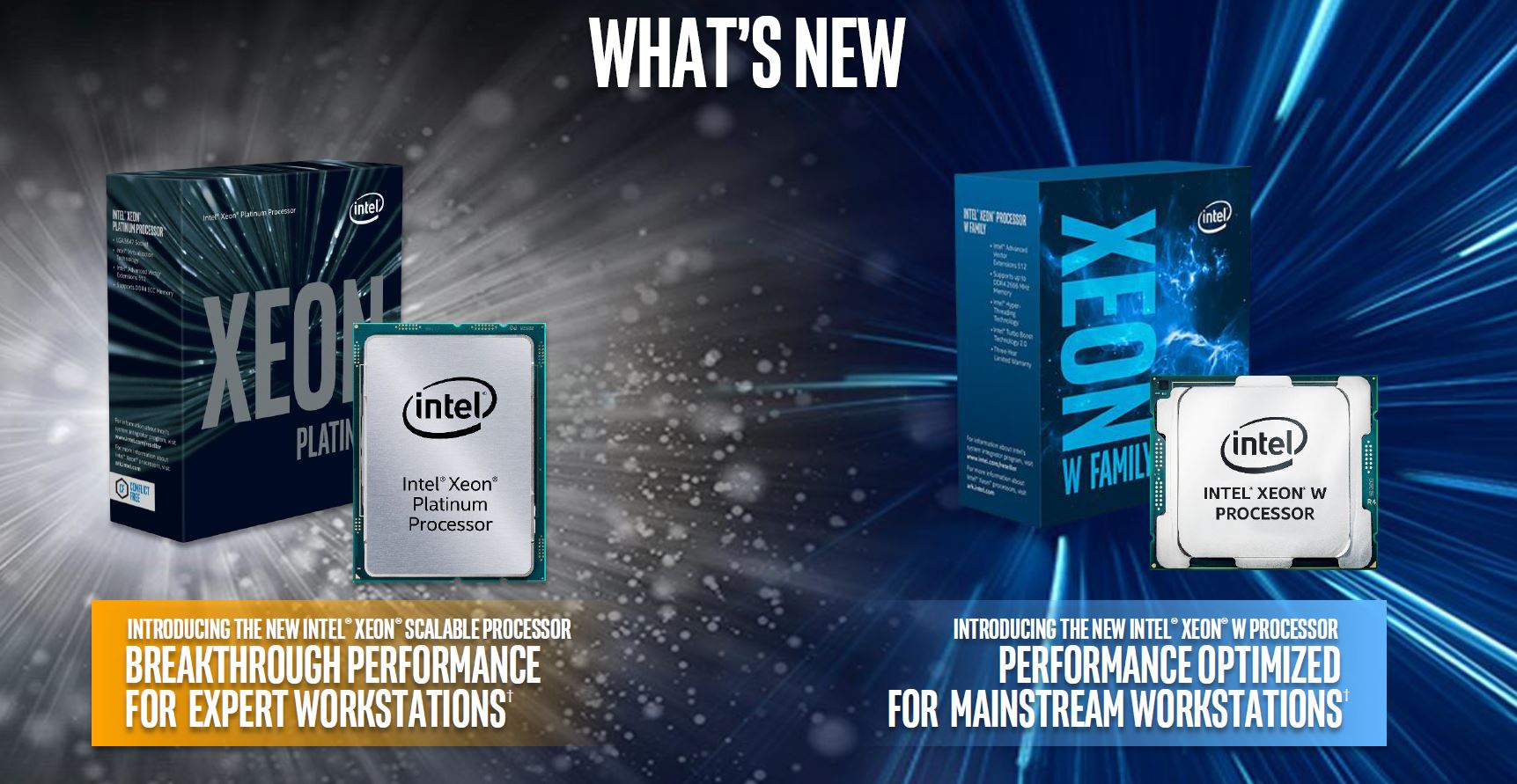
We did an absolute ton on the Intel Xeon Scalable series. See Intel Xeon Scalable Processor Family (Skylake-SP) Launch Coverage Central. Here are the Xeon Scalable / Skylake-SP SKUs Intel sees as “workstation” capable.
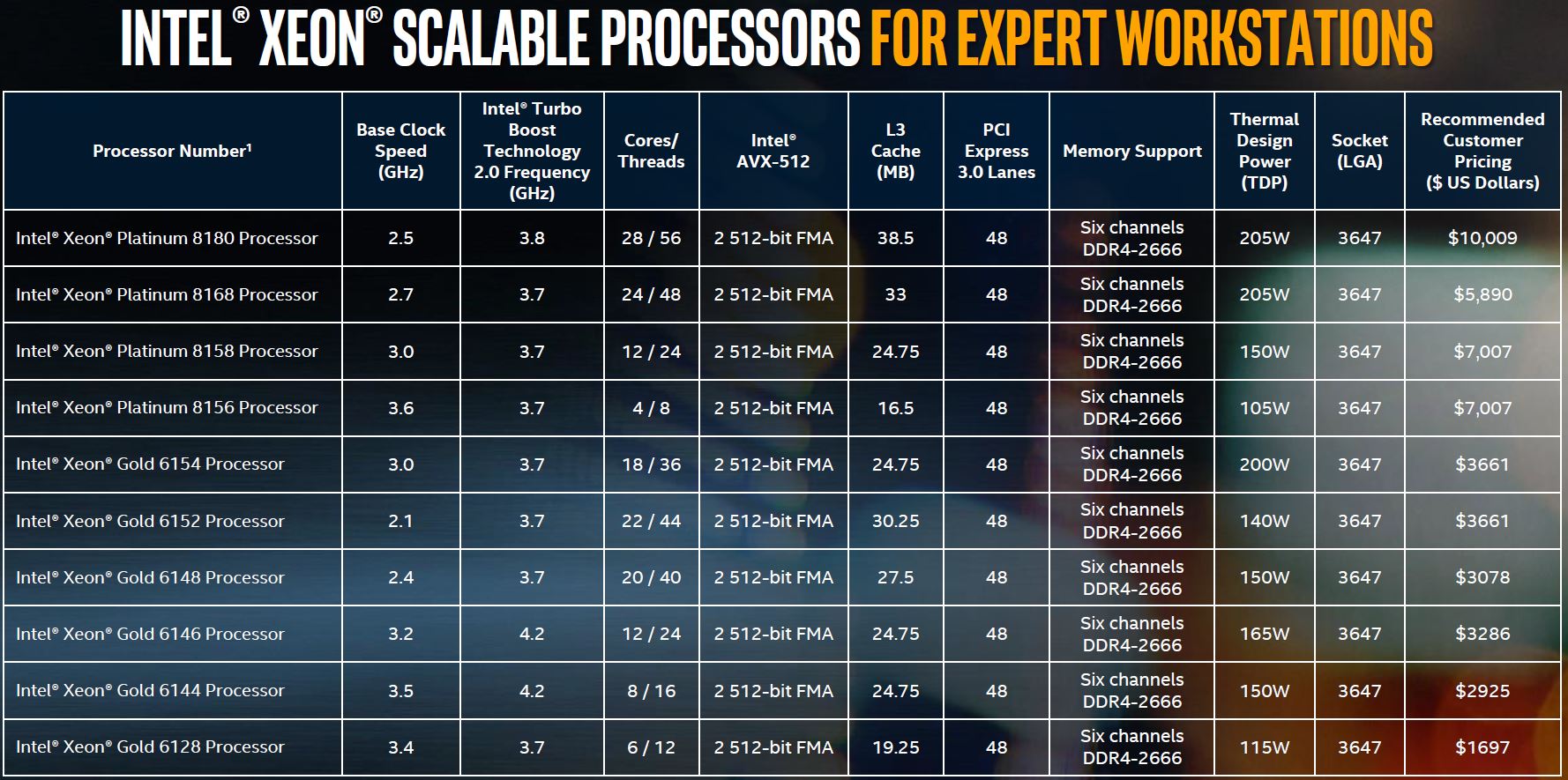
It seems that Intel is drawing a line in the sand with 3.7GHz and only Gold 6100 series or higher SKUs.
The new release centers around the Intel Xeon W series processor. Here is the overview slide:
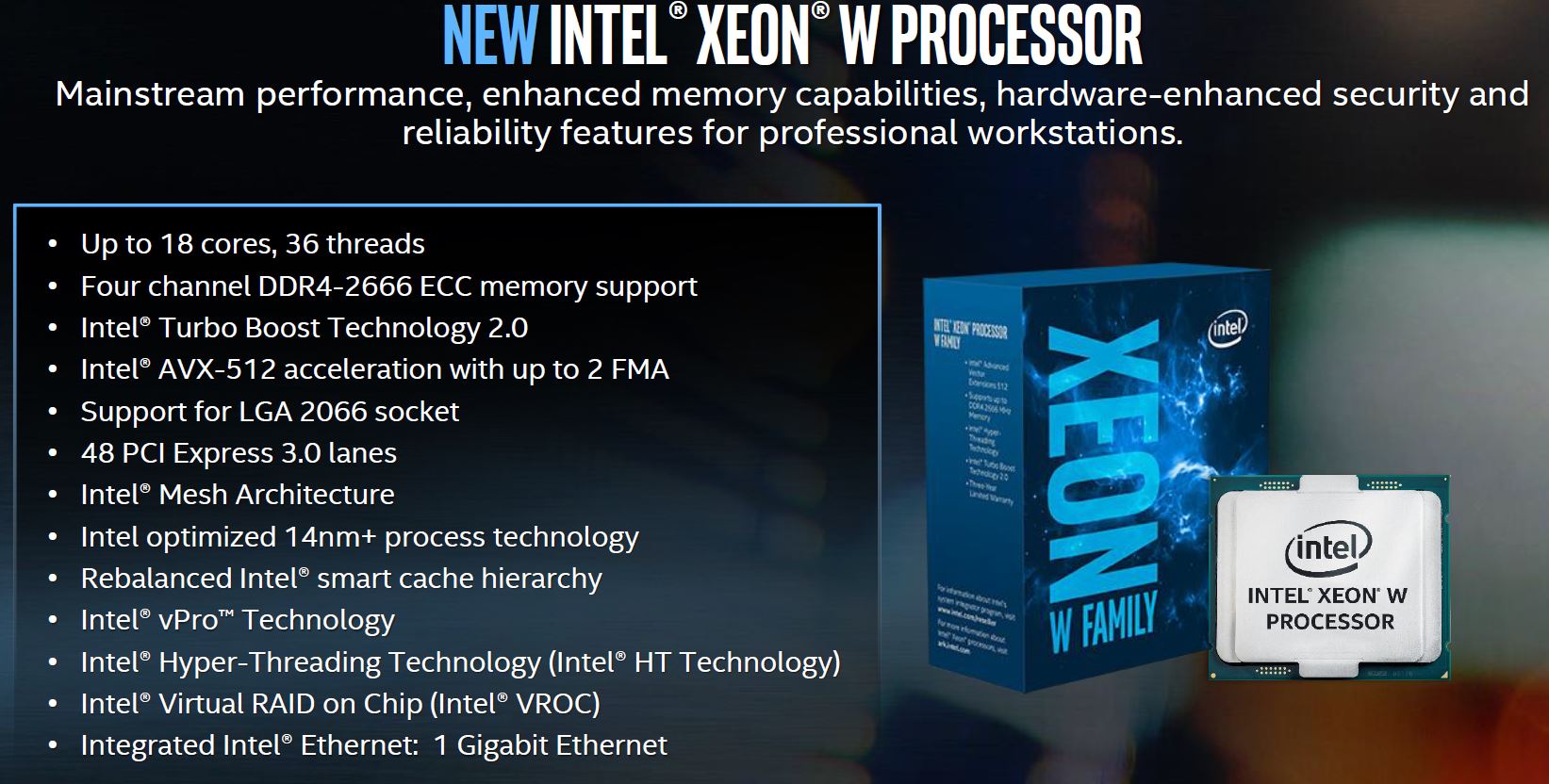
Unlike X299 platforms, everything is enabled. 48x PCIe 3.0 lanes. DDR4-2666 across the SKU line. ECC memory support (quad channel.) LGA 2066 and up to 18 cores / 36 threads.
The new platform rides atop the Intel C422 chipset. While the Intel C622 chipset for Xeon Scalable has dual 10GbE, the C422 has only a single 1GbE. Again, this is another instance of Intel Xeon product naming and numbering getting harder to understand.
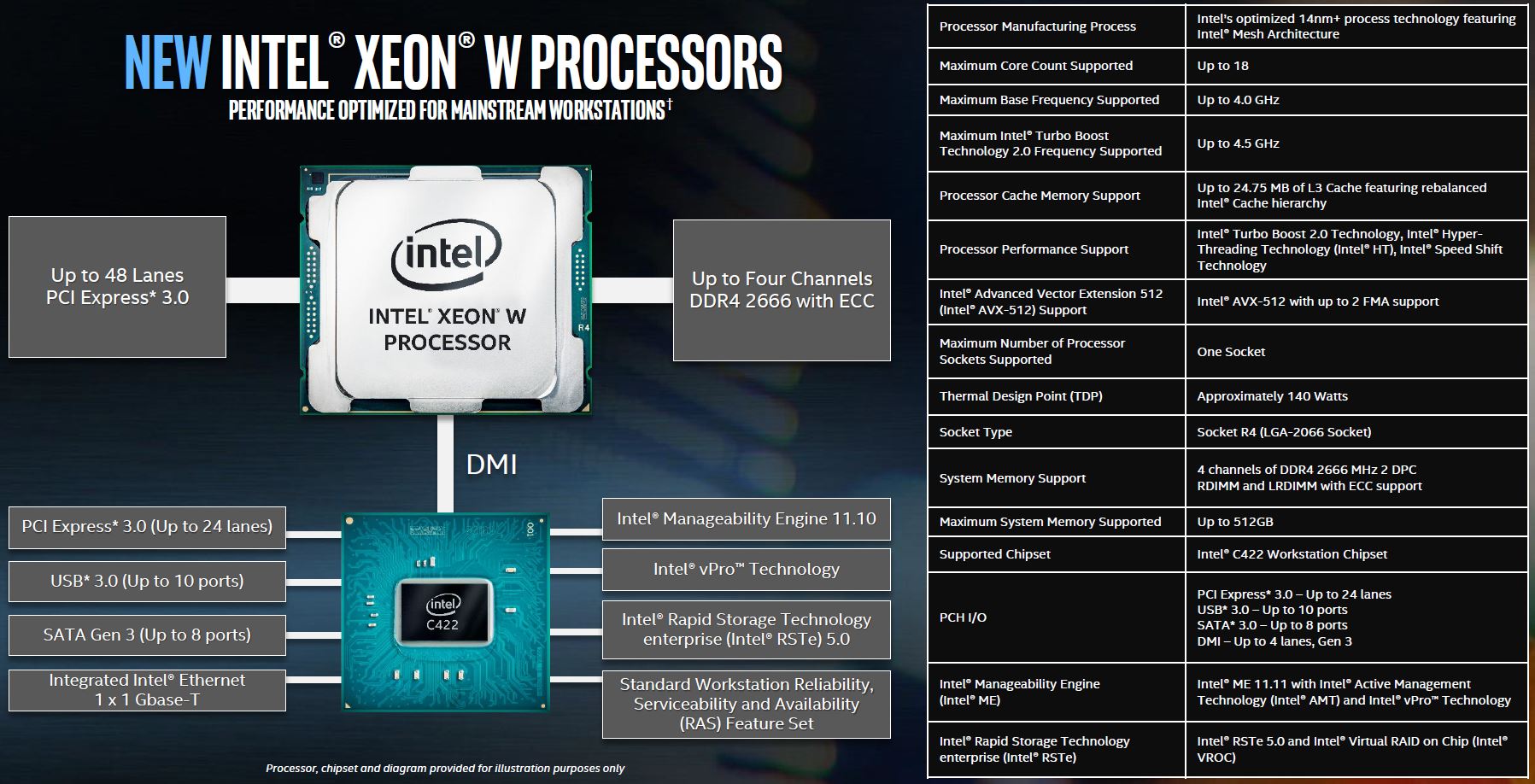
Key here is that one can use up to 512GB DDR4-2666. That figure is interesting since using 2 DIMMs per channel, four channels and 128GB LRDIMMs would yield a theoretical 1TB RAM support or more than a server Skylake-SP non-M chip. From the motherboard manufacturers we have spoken to, the platform is supposed to support up to 32GB RDIMMs and 64GB LRDIMMs.
SATA in this generation is down to only 8x SATA III ports. That is certainly a small downgrade over the previous generation. While very few high-end workstations will use that many SATA disks, we have little doubt that some motherboard vendors will provide add-on controllers to reach parity with the previous generation parts. This is the first sign that the SATA III interface is waning in its importance.
Intel Xeon W SKUs for Workstations
Here is the official SKU list for the new workstation parts:
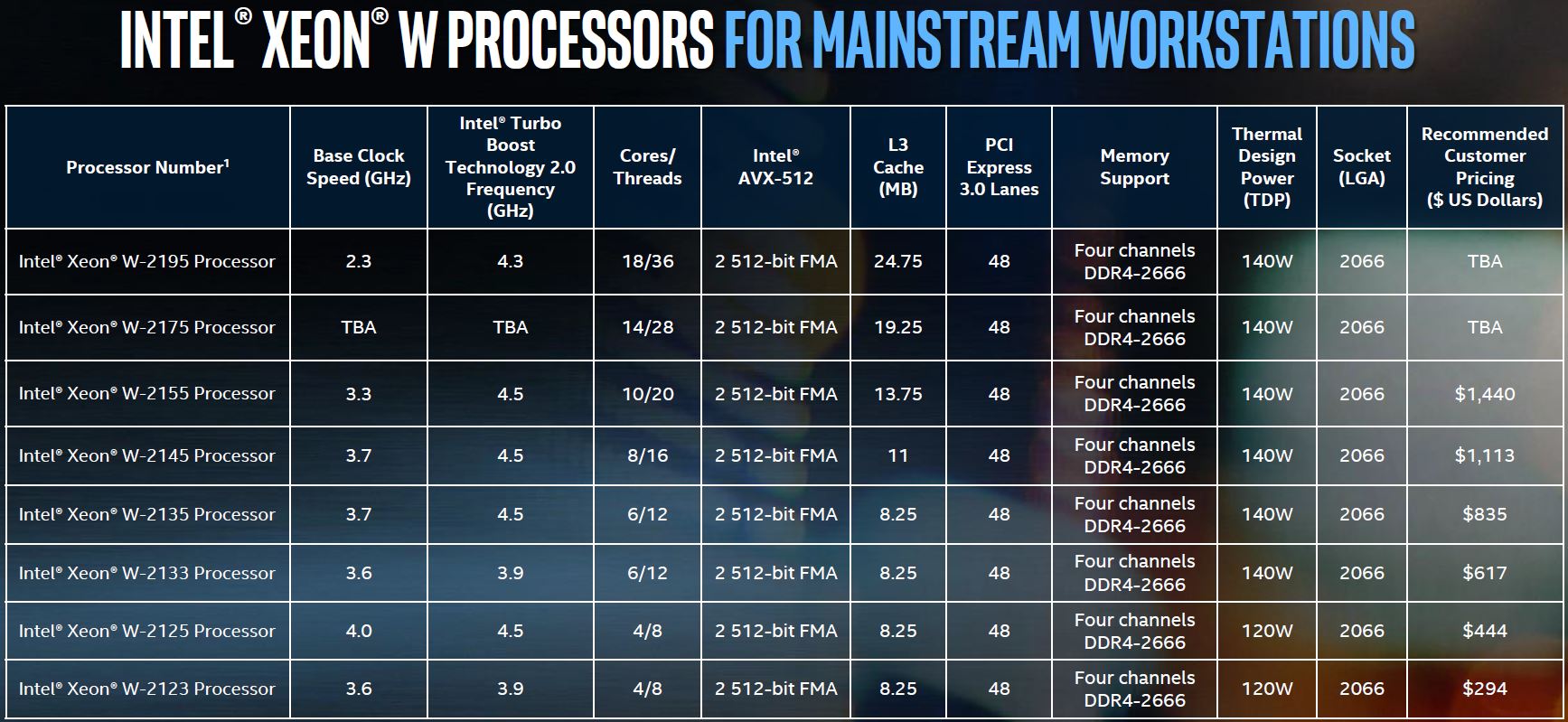
2x AVX-512 puts the AVX capabilities closer to the Xeon Gold 6100 and Platinum 8100 series. The software ecosystem is starting to support AVX-512 so that is a major consideration.
Here is a quick look at the SKU list in a more standard STH format

If you want more threads and do not need high clock speeds, there are quite a few options in the Intel Xeon Silver range that could be intriguing.
Final Words
If you have had an Intel Xeon E5-1600 (V1-V4) series system, this is a major expansion of the lineup. While one gives up a few SATA ports, one gains more PCIe lanes. We were a bit shocked to see the news that the platform does not get 10GbE built-in. That is now a low-end embedded feature with the Intel Xeon C3000 series. It is 2017 so not seeing this as a standard feature is borderline shocking, even on motherboards such as the Gigabyte MW51-HP0.
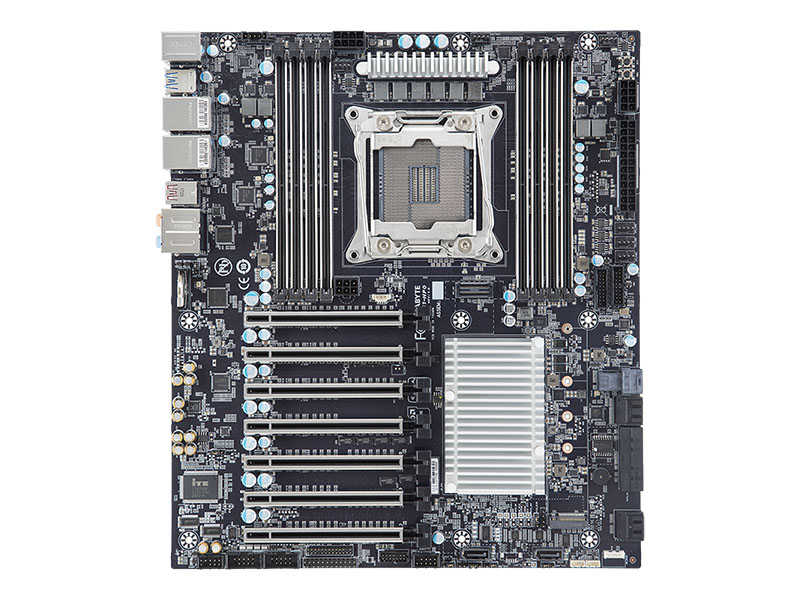
If you previously utilized dual socket workstations, the flip side is that the new options cost significantly more. An Intel Xeon E5-2687W V4 has the most direct successor in the Intel Xeon Gold 6136 at about a 10% price premium. That is one of the lower-cost Intel Xeon Gold series CPUs.
On balance, this is a major step forward from the Intel Xeon E5-1600 V4 line. It is also a major departure as it is the first time in over half a decade since the single socket Intel Xeon workstation part (excluding the Xeon E3 series) used a different socket than the dual socket variants. Intel’s new model is toward higher prices and that is reflected in this newest generation.

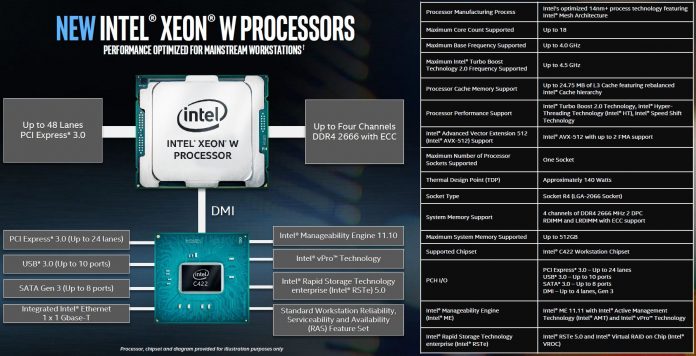



SuperMicro has a Chassis supporting an ‘unannounced’ (no Webpage) pair of Motherboards, X11SRM-F and X11SRM-VF micro-ATX supporting 128GB Registered ECC RDIMM or 256GB Load Reduced ECC LDIMM both using the C422 and dual 1GB Networks.
Source: https://www.supermicro.nl/ResourceApps/MB_matrix.aspx .
SuperChassis 813MFTQC-R407CB: http://www.supermicro.com/products/chassis/1U/813/SC813MFTQC-R407CB .
Also the Gigabyte MW51-HP0 is mentioned here at STH: https://www.servethehome.com/new-gigabyte-mw51-hp0-intel-xeon-w-workstation-cpus/ – is CEB size: http://b2b.gigabyte.com/Server-Motherboard/MW51-HP0-rev-10#sp .
Nice addition Intel, but I’m still wondering. If I need to go <100W TDP on CPU, then is it possible to down-clock the CPU or limit TDP by other way? If so, then what would be the performance in comparison with let say E5-2640v4 with TDP 90W which is so far IMHO the best/fastest CPU 64GB RAM.
Motivation: I wound’t like to part with my Zalman TNN 500 AF fan-less case which does have max 100W TDP on CPU requirement, but yet would like to upgrade from old SandyBridge E5-2620 which is running inside it for a lot of years now…
@KarelG
Have a look at Ryzen 7 1800X, it has a TDP of 95 Watt is easy to down-clock, can handle 64GB RAM and has the highest performance per/watt for a multi core around the tdp of a 100 Watts.
@Misha: Ryzen looks really nice. The problem is, I need to be prepared for more than just 64GB RAM (heck, 64GB RAM is in my current 5 years old workstation). Hence I even do not consider Intel’s Xeon E3 which also ends on 64GB RAM. The *BIG* pitty for me is that Ryzen 7 in whatever variant does not support RDIMMS/LRDIMMS like Threadripper does. This is really a pity for me… Well, otherwise it would be a nice option of course!
@KarelG
Why do you want so much RAM in a fanless case?
@Misha: this is my workstation and I write server-based applications for living, so I kind of need more RAM.
To my eyes, Threadripper is much more interesting because of its lower price. Intel lost a great opportunity to differentiate Xeon W by using their 10GBe tech and an iGPU.
From the article, it was not clear if the number of available PCi-e lanes is 48 or 24. The processor has 48 lanes, but on the slide it says 24 lanes only (does the chipset use the other 24 lanes?).
If it is only 24 lanes available, then TR is indeed ahead with its 32 lanes.
Too bad that all TR motherboards I can find are gaming mobos. Even the workstation ones seem to be targetted at gamers. Hoping this will change soon.
@KarelG: XEON Bronze, silver and Gold 5115 and 5119T are upto 85 Watt TDP and can handle 768 GB of RAM and also have 48 PCIe-lanes, so choice enough.
@Misha: please have a look onto Xeon E5 2640v4. Provides up to 3.4GHz, has bigger L3 and yet it’s price is lower than for example 5115. 5119T seems to not be generally available (even Intel does not mention its price?) and my experience with silver and/or bronze is that all run just on lower clock. 2640v4 also can use up to 1.5TB of RAM in comparison with half of this available on Gold. The point is, is really Intel that lazy in innovation or does intel’s marketing department got mad with those prices/setups of SP xeons? Yes, I know SP provides 48 PCIe lanes while E5 just 40. For me not important detail, I’m software engineer I just need balanced number of cores/single-threaded perf CPU and a lot of ECC RAM.
@KarelG: Sorry Karel, I had the impression that you were looking for a cpu with a TDP below 100 Watt. The way I read it now is that you blame intel for the lack of innovation, well they have done that for the last 7 years or so. Maybe next year, when they will be hurt even more by the new GloFo 14 nm+ for ZEN+.
They are still lucky that AMD haven’t allowed mobo makers to use registered ECC DRAM for Ryzen(upto 1TB) and Threadripper(upto 2 TB).
@Misha: indeed, you are right, I’m blaming intel, but it’s completely useless. As you recommend let’s wait and see. AMD especially may be interesting with non-X version of TR 1900. I would probably not hold my breath for Ryzen RDIMM support on any board except perhaps highly specific industrial computers. Well, if AMD is a no go, then indeed, there is still intel chance with older E5-2640v4 which still looks like a best deal from them under 100W TDP.